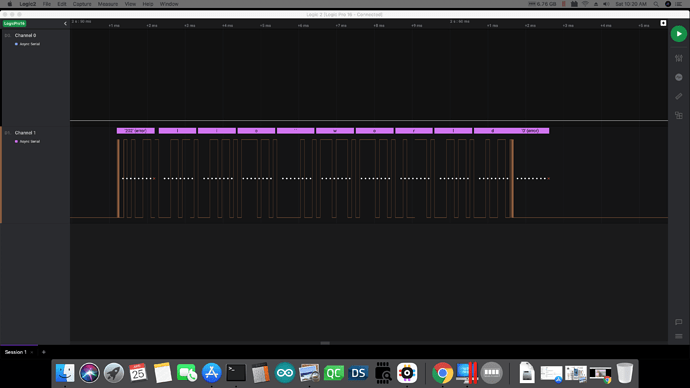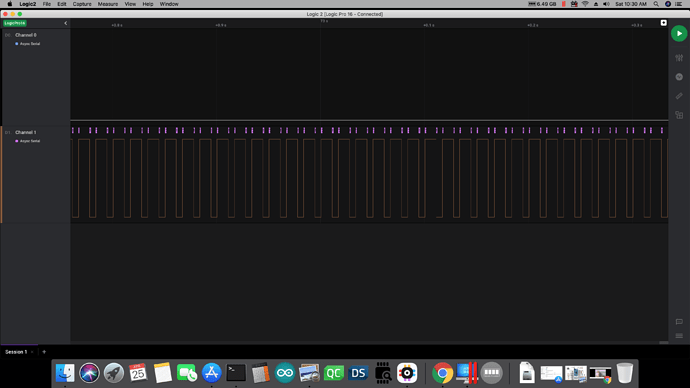@ansonhe97, that’s exactly opposite from what I found here using a logic analyzer (LA). Here is a screen shot of my trying to send data over Serial1, with the LA on pins 1 & 3 of the 28-header (pins D0/D1):
As you can see, there are indeed characters being sent on the 28-pin header UART pins 1 & 3 (D0/D1). The signal you see in that screen shot was obtained at 9600 baud, on pin 3 of the Arduino header (28-pins), and NOT the Tx pin of the 4-pin header. So there is data being sent on the Arduino header pin 3 (D1), but there are a number of framing errors–which almost suggests that there’s a stop bit problem, as far as I can tell. There are apparently other reasons for a framing error, but one I found mentioned was that there is a problem with the stop bit not being sent correctly.
As for the 4-pin header, this screen shot shows what I found with the LA on pin 2 (Tx pin) there:
As you can see, there is a strange semi-symmetrical waveform there. The on-time was around 10 ms, while the off-time was just over 6 ms. So it wasn’t a truly symmetrical waveform, in terms of on/off time. But no matter what I tried sending from my Arduino sketch (one of the examples that comes with the IDE), there is absolutely NO data at all being sent on the 4-pin header. Note that I did not get any sort of traffic on the Rx pin of either header at any time, but I will try to connect a GPS to each of the Rx pins (on both headers) and see what happens then.
The other thing I want to try today is to just put a LA on that 4-pin header without calling Serial1.begin() or SerialUSB.begin() in the code. I didn’t try that the other day when I took these screen shots, and I think it will be interesting to see whether or not that asymmetric square wave is on the 4-pin Tx pin when the UART hasn’t been initialized in code. I will also try these things on a Teensy or Arduino, and to see how things go there. But I’ve never seen that sort of pattern on a UART before–especially one that shows no data being transferred at all.
So like @wx4cb found, my experimentation here shows that Serial1 is on pins 1/3 o the 28-pin header (D0/D1), while pins 1/2 of the 4-pin header don’t seem to do anything. I simply cannot yet explain all the framing errors I found.
Thanks for your response on this issue.
TB

